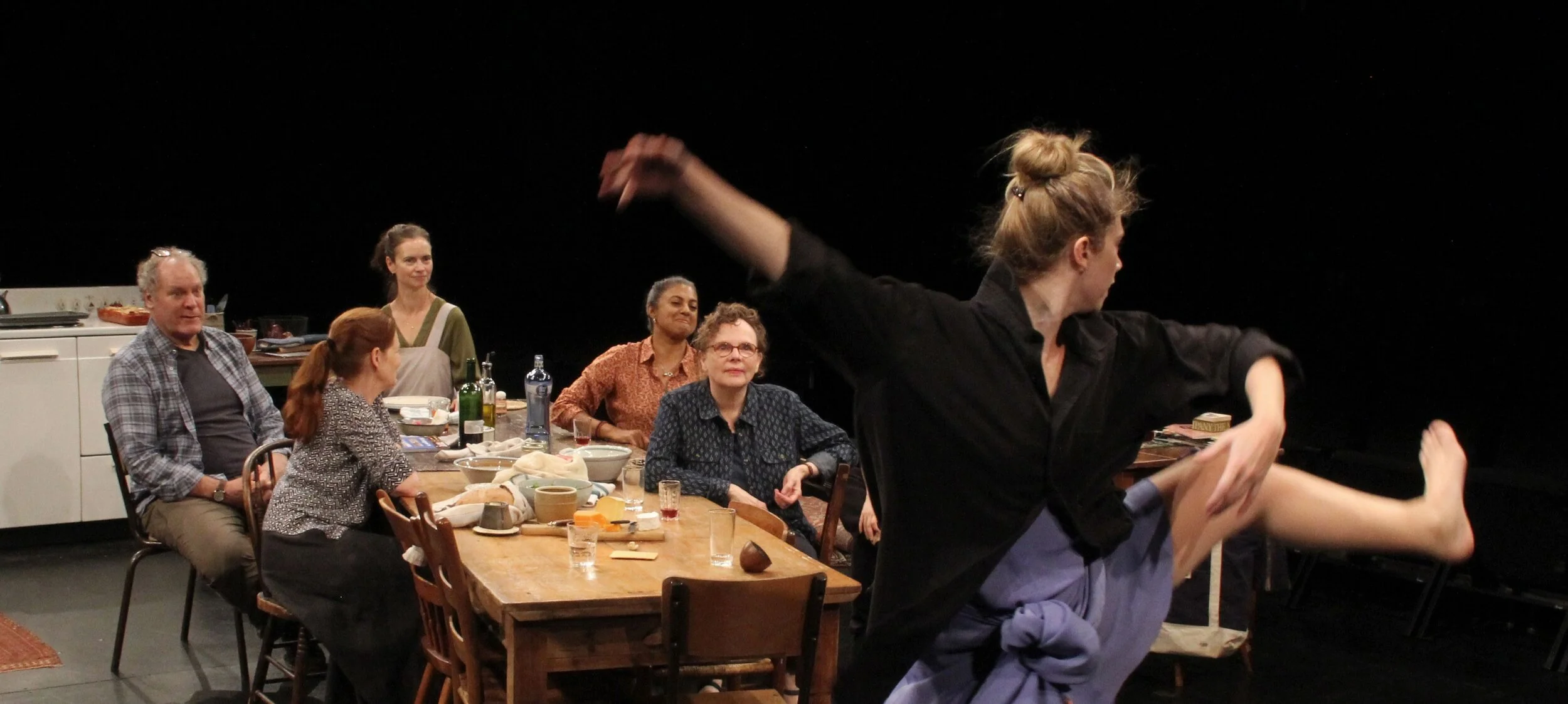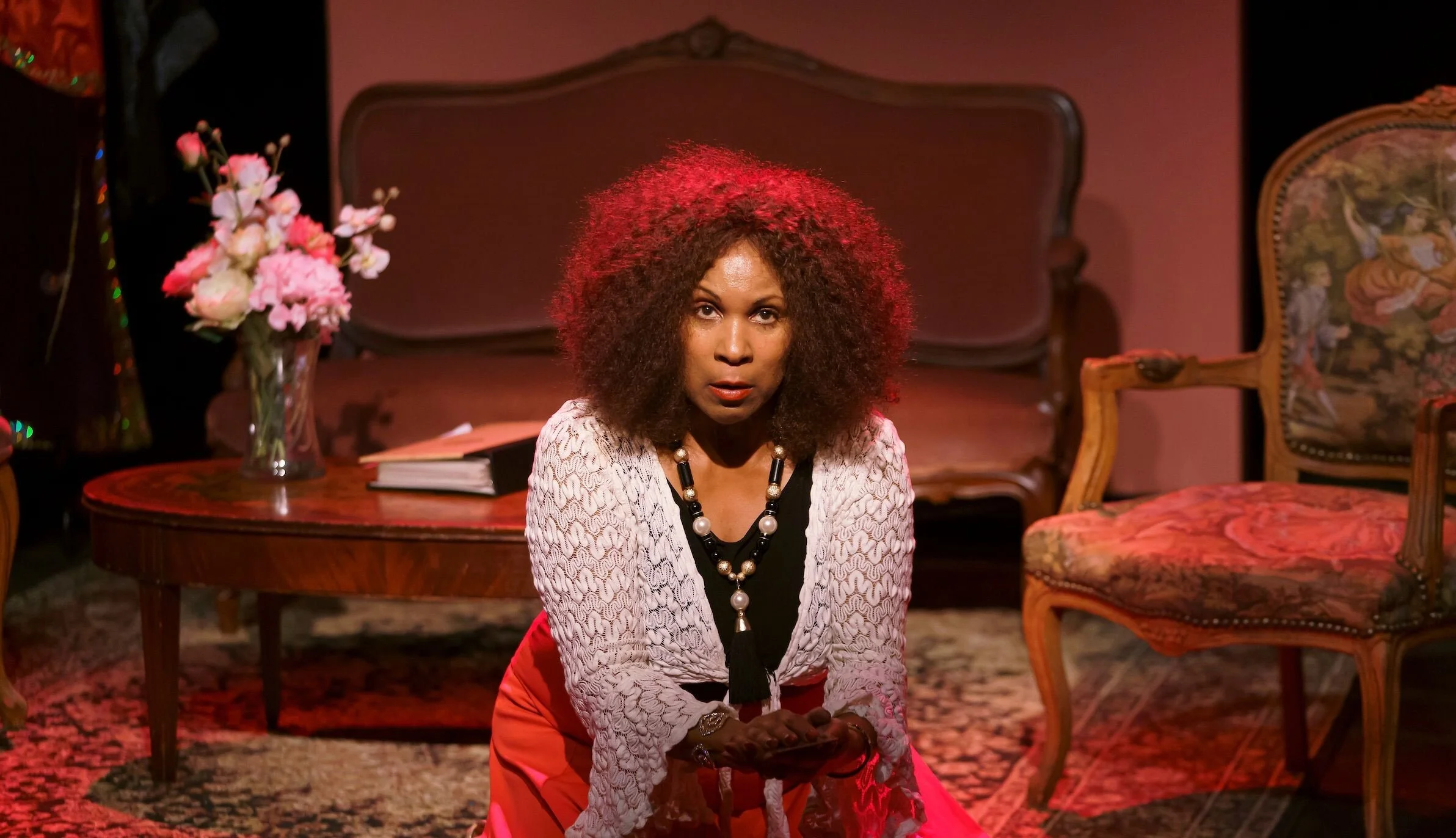The programs handed out at Martyna Majok’s Sanctuary City, produced by New York Theatre Workshop and presented at the Lucille Lortel Theatre, note that they have been “frozen in time”: they were printed for the play’s original run, which began in March 2020, and are now accompanied by a QR code providing updated information. This new information includes a remount director, Caitlin Sullivan, in addition to the original direction by Rebecca Frecknall.
What Happened?: The Michaels Abroad
It finally dawned on me that theater was back in New York City when I was once again in the presence of characters in a Richard Nelson play as they sliced bread, grated cheese, sipped wine, and had conversations that made you feel like an eavesdropper more than an audience member.
Merry Wives
Farce, with its antic misunderstandings and confused identities, can polarize audiences. Spectators may either be exhilarated by the pandemonium or left cold. With Merry Wives: A Celebration of Black Joy and Vitality, the sole production of this summer’s Free Shakespeare in Central Park, playwright Jocelyn Bioh gambles that, after a year of societal strife, she can unify audiences by updating William Shakespeare’s rambunctious farce The Merry Wives of Windsor.
Friends: The Musical Parody
If you’ve never watched Friends, the TV megahit that aired from 1994–2004, that wouldn’t preclude you from enjoying Friends: The Musical Parody. It’s hysterically funny, and concisely captures the idiosyncrasies of every one of the six characters who provokes, pairs off with, or parts ways with another.
Charmed Life: From Soul Singing to Opera Star
Many an autobiographical solo show has been born from hardship— growing up closeted, say, or having an intolerable job, or living through a war. Lori Brown Mirabal’s jumping-off point is the complete opposite. It’s right there in her show’s title, Charmed Life: From Soul Singing to Opera Star.
Fruma-Sarah (Waiting in the Wings)
In Fruma-Sarah (Waiting in the Wings), the multitalented Jackie Hoffman portrays Ariana Russo, a barely talented amateur actor who is literally and figuratively at the end of her rope. Stuck in the minor role of the ghostly and ghastly Fruma-Sarah, in a community theater staging of Fiddler on the Roof in Roselle Park, N.J., she must spend the first “hour and seven minutes” of the show offstage, strapped in her flying harness and waiting for her cue to soar.
Voyeur: The Windows of Toulouse-Lautrec
Voyeur: The Windows of Toulouse-Lautrec explores the life of Henri de Toulouse-Lautrec, the immensely talented 19th-century French painter and printmaker, using the sidewalks, doorways, and windows of Greenwich Village as the setting for a “pandemic-friendly theatrical experience.” Live performance, puppetry, music and a short black-and-white film combine to help the site-specific production tell the story of the artist who captured the seamier side of the Belle Époque.
The Siblings Play
In mid-March, as the novel human coronavirus steamrolled New York City, Rattlestick Playwrights Theater had to pull the plug on Ren Dara Santiago’s The Siblings Play. The production, directed by Jenna Worsham, was nearing the end of previews, with four days to go before opening night.
About Love
Jazz artist Nancy Harrow is one of the New York music world’s greatest, though woefully underappreciated, treasures. During the Kennedy and Johnson eras, she was a regular on New York City’s cabaret circuit, singing with figures such as Kenny Barron, Bob Brookmeyer, and Jim Hall. Back then, Village Voice critic Nat Hentoff wrote: “Nancy Harrow is not jazz-influenced or jazz-tinged or jazz-pollinated. She is without qualification a jazz singer all the way.”
Love Quirks
The soundtrack as you walk into St. Luke’s ought to provide a hint: it’s American songbook standards, like “In Other Words” and “Fever,” rendered by the likes of Frank Sinatra and Peggy Lee, respectively. It primes the audience to expect a retro evening, and Love Quirks, the new musical by Seth Bisen-Hersh (music and lyrics) and Mark Childers (book), while set in the present-day New York of Instagram and Grindr and Twitter, is retro. It wants to be a sweet old-fashioned evening of melody and humor and light romance, and some of the time it succeeds.
Mr. Toole
The title character in Vivian Neuwirth’s Mr. Toole is John Kennedy Toole, author of the 1981 Pulitzer Prize novel A Confederacy of Dunces. Known as “Ken” to family and friends, Toole died in 1969, more than a decade before his book was published. Neuwirth knew Toole when she was a student at St. Mary’s Dominican High School in New Orleans, where he taught English. “He was,” she says, “an amazing teacher” with a “theatrical flair.”
Seven Sins
The work of Austin McCormick, the polymath artistic director and choreographer of Company XIV, may be handily classified as burlesque—costumer Zane Pihlstrom provides more than enough feathers, fringes, and pasties to justify it—but that label doesn’t really fit a production that incorporates dance, opera, pop music, and acrobatics as well. All are on display in his newest effort, Seven Sins.
Incantata
Incantata, by Pulitzer Prize–winning Irish poet Paul Muldoon, is an elegy crafted into a theatrical narrative that loosely weaves together erudite poetic imagery and concrete memories with literary and artistic references. The experience is a journey through bumpy waters, a sensory and linguistic adventure with Stanley Townsend, a tremendously talented and physical actor, at the helm of the solo show.
Sideways
When writer Rex Pickett was trying to get his novel Sideways published, he submitted it to film studios as well as book publishers. He has now adapted the novel as a play, but the story’s cinematic nature works against it on stage. Because there are so many scene changes, scenery is simplified to tables and chairs (and the occasional counter or bed) that can be hastily reconfigured to represent various homes, bars, restaurants and outdoor locales. But Sideways has such a strong sense of place—the Oscar-winning 2004 movie fueled a tourism boom for California’s Santa Ynez Valley, and a map of film locations is still available on the Santa Barbara visitors bureau website—that it’s shortchanged by many scenes looking similar and the same backdrop, a lone tree, remaining for the entire play. What scenic designer David L. Arsenault has created is okay (the multiple levels and a faux hot tub work well); it’s just not enough to evoke the landscapes and idea of traveling.
Suicide Forest
The challenges are as great as the rewards in Haruna Lee’s Suicide Forest, a tortured, weird, and very personal fantasy that includes passages spoken in Japanese, bouts of simulated schoolgirl molestation, and a lengthy scene in near darkness with characters dressed as goats and wearing headlamps. But those willing to go along on this guilt trip, skillfully guided by director Aya Ogawa, will be find unexpectedly beautiful moments of theatricality and an ending that pivots from madness to reality with the force of an emergency brake being thrown on a speeding train.
The Unsinkable Molly Brown
When Dick Scanlan files his taxes, under Occupation, does he put “Richard Morris rewriter”? Morris, a middling mid-century scribe, penned the screenplay for Thoroughly Modern Millie, revised successfully for Broadway by Scanlan in 2002. Now Scanlan has “revitalized,” as the marketing for it goes, The Unsinkable Molly Brown, a 1960 Broadway hit, with a book by Morris, that was Meredith Willson’s follow-up to The Music Man. Scanlan’s Millie, to these eyes at least, was a sloppy rehash of an awkward premise that didn’t know exactly what it wanted to be. (You can judge for yourself when Encores! encores it in May.) But on Willson’s Molly, it turns out, Scanlan has done a bang-up job.
A Sign of the Times
The solo play A Sign of the Times stars Javier Muñoz as a former physics professor who now works as a traffic controller near a construction site. Sounds of vehicles zooming past, slowing down or screeching to a halt are heard frequently, and Muñoz occasionally speaks with their unseen drivers.
The Confession of Lily Dare
It’s been quite a while since Charles Busch, the playwright and performer who specializes in sending up old movie tropes in works like The Divine Sister and Red Scare on Sunset, has had a show that he deemed ready for review, so The Confession of Lily Dare counts as a successful return to form. It’s a loopy satire of film melodramas about fallen women, although its most prominent forbear is Shaw’s Mrs. Warren’s Profession (first performed in 1902). Few performers can discern Hollywood camp as well as Busch: he has even provided commentary on DVD releases of The Bad Seed and Dead Ringer.
Blues for an Alabama Sky
Blues for an Alabama Sky, by Pearl Michelle Cleage, has been around for 25 years, but only now has the Keen Company given it a New York debut. Still, Cleage’s work, about black artists struggling in 1930, during the Harlem Renaissance, is as relevant today as it was a quarter-century ago. Poverty, discrimination, abortion rights, violence, and the everyday hustle to make it are still real issues in 2020.
Tumacho
Tumacho, the Clubbed Thumb production now playing a return engagement at the Connelly Theater, begins with a chorus of performers onstage. Their faces are lit hauntingly in red as they sing a solemn tale, introducing how “hope has left/from a town bereft” and the need for “lasting peace.” The scene should be a downtrodden one—except it isn’t these human performers that are supposed to be doing the singing. Instead, it’s the saguaro cactus puppets (complete with Muppet-like faces) each singer wields that are narrating this haggard tale. This grizzled silliness comes to define Tumacho, a portrait of the Wild West where characters combat ennui, hopelessness, and impending doom—without ever taking themselves too seriously.
























